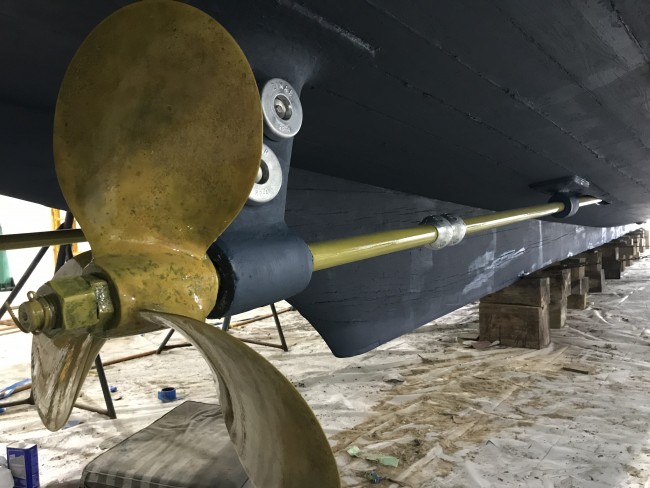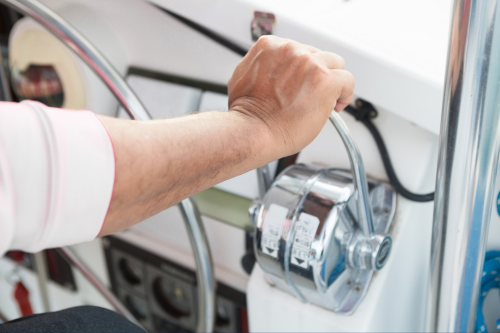
A Wide-Open Tale
Several years ago I was carrying out a sea trial aboard a single screw trawler that a client of mine was considering for purchase. Part of the process involved operating the vessel's engine at full or wide-open throttle, what engine manufacturers often refer to WOT. The boat yard where the vessel was stored launched it; I boarded along with my client, the yard's chief mechanic, who was also an experienced captain, and the selling broker. Shortly after we slipped our lines and moved away from the dock, I explained to the captain the sea trial protocol I wanted him to follow, including the WOT test, and I asked that he operate the vessel at WOT for 10 minutes. He looked at me with a pained expression and simply said, "Negative." I asked what the problem was and he responded by saying, "We don't run engines at full throttle around here." I explained that every engine manufacturer clearly specifies a WOT rating, and the only way to ensure the engine can achieve it, and thereby ensure the proper match with the propeller and reduction gear, is by running at full throttle.
In the case of this engine the manufacturer specified that it could do so for up to 30 minutes without any ill effects. The WOT duration is specified by each engine manufacturer; it typically ranges between 30 minutes to several hours, up to as much as 100% (i.e., an unlimited WOT duration). The captain was doing what he believed was right--of that I have no doubt--however, he, like many boat owners and professionals alike, was under the misguided impression that operation at WOT is harmful. While that's true in cases where the propeller is over-pitched, or otherwise mismatched to the engine, thereby leading to overloading, that wasn't the case here, and the only way to determine if there is a mismatch is to find out by running at full throttle, at least briefly. Finally, to his credit, the broker offered to call the local dealer for the engine for guidance on the subject. With his phone on speaker, they made it clear that WOT was more than appropriate for as much as 30 minutes. With that clearance, the captain agreed to carry out the test, as long as he was absolved of responsibility for any components that "melted or otherwise failed." As it turned out, the boat and engine performed flawlessly, the engine achieved its rated WOT and the sale proceeded. Regrettably, that's an exception to the WOT testing rule; many vessels fail to achieve this important benchmark.

Wide Open Throttle Testing
Every marine engine carries a WOT rating established by its manufacturer; it's the rpm that the engine is designed to turn up to when the throttle is pushed to its limit. For conventionally fuel-injected diesels, successfully carrying out this test involves making certain the throttle lever on the fuel injection pump reaches its stop. For electronically controlled engines, the user must ensure that the engine instrument display indicates 100% load. WOT sea trials should be carried out with the vessel in normal operating or cruising trim (i.e. 50% to 75% fuel and water), and all or must typical cruising stores aboard. In other words, the boat should be set up in a manner that equates normal use. The showroom new boat with little fuel and no personal belongings aboard would offer something less than an accurate, real world WOT test.
Why Do It?
There are several reasons for carrying out such a test. Foremost among these is ensuring that the propeller (and transmission reduction gear) is properly matched to the engine. If a propeller has too much pitch, is too large in diameter, has too many blades or has too much blade surface area (sometimes referred to as "over propping") for a given engine application, it will prevent that engine from reaching the manufacturer's established WOT rating.
In the case of a mechanically injected engine this will lead to a phenomenon known as over fueling, whereby more fuel is injected into the cylinders than can be efficiently burned, which results in poor fuel economy, cylinder coking and black smoke, premature oil contamination and fuel dilution, and excessive combustion chamber temperatures. For electronically controlled engines, over propping will often be recognized by the electronic engine control, which leads to an automatic reduction of fuel being injected into the cylinder, thereby protecting the engine from damage and minimizing smoke; however, the scenario remains undesirable. In effect, the engine's computer de-rates the engine, which may mean a 400-hp engine becomes a 350-hp engine, without the operator recognizing it, especially if the problem has existed from the day the boat was built, or for as long as it's been in the possession of an owner. In short, if that's the way it's always been, it's difficult to identify the problem. It's important to remember that even if you never intend to operate the engine at WOT, ensuring that it can achieve this rpm is critical, as it means the propeller is properly matched to the engine and that the overall installation is sound. Nearly all engine manufacturers insist that their engines meet this rating, and their warranties are nearly always predicated on achieving this all too important benchmark. If an engine fails and the failure is attributable to over-loading, an engine manufacturer could deny warranty coverage based on the incorrect propeller having been used. Even if the engine is out of warranty, a failure of this sort is, and should be, entirely avoidable.
Another reason for ensuring your engine can achieve and maintain WOT involves the efficiency of its cooling system. A sure way to determine the health of your engine's cooling system is to run it at WOT. It should not overheat; however, many engines I test are incapable of operating for more than a few minutes before the temperature gauge begins to creep into the red. I've heard this explained away many times as "normal", I'm told that engines aren't designed to operate at this load. Nothing could be further from the truth. If an engine overheats at WOT, something is wrong with the engine or the installation, and there are variety of possible causes. The exhaust system must also be included in the WOT overheat test. It's possible for it to overheat while the engine runs at a normal temperature. During a WOT run, the dry and wet portions of the exhaust system should be tested using an infrared pyrometer. No portion of the dry exhaust system that can be accessed or touched should exceed 200°Fahreneit. (This is mandated for compliance with American Boat and Yacht Council guidelines.) Ideally, no portion of the wet or water-cooled exhaust system should exceed 160° Fahrenheit.
The reasons for WOT overheating include clogged heat exchangers, worn out impellers and pump cams, obstructed exhaust systems (remember that all cooling water typically exits through the exhaust, and if it's restricted, it slows down all water flow) or, most insidiously, a flaw in the raw water intake system's design. It's not unheard of for new vessels to overheat when run at WOT, and, in many cases, the problem can be traced to the design of the raw water-cooling system.
Typically, when an engine fails to reach WOT the first reaction of the builder, yard or owner is to remove the propeller and have the pitch adjusted. In fact, this is the last corrective action that should be taken. Prior to adjusting the propeller, the exhaust system backpressure should be checked. If it's too high, it will lead to a reduction in RPM that pitch reduction will simply mask. The engine must be checked to ensure it's in good working order, that there's unrestricted air and fuel flow and, for older engines fuel injection systems, should be scrutinized and the valves should be checked to make certain they are correctly adjusted. Once those possibilities have been ruled out, then propeller pitch may be adjusted to correct WOT issues. It's important to note, many new vessels suffer from a failure to reach WOT, which means no assumption should be made regarding these vessels and their compliance with engine manufacturer's guidelines.
Finally, part of the WOT test involves determining the engine's governed RPM (that is, at what rpm will the engine limit itself to prevent damage). Typically, this is 50 to 100 rpm above the WOT; however, it may be more. Before carrying out a WOT test, while the engine is in neutral, the throttle is advanced to its maximum setting for a few seconds to determine the governed rpm. If, during the subsequent fully loaded WOT test the engine once again reaches the governed RPM, the propeller is likely under-pitched, has too few or too small blades, or the diameter is too small. While over-revving (i.e., under-loading) isn't as detrimental as under-revving and over-loading, it still represents a fault and a loss of efficiency and unrealized horsepower that has been paid for and that must be corrected. Ideally, when fully loaded and in cruising trim, your engine should run at between 0 and 50 rpm above the WOT rating.
A final caveat regarding WOT testing: Engines that are ill-maintained, in poor operating condition or suffering from other known defects should not be subject to WOT testing until their issues have been corrected.
Steve D'Antonio is a marine systems consultant offering services to boat buyers, owners and the marine industry, as well as an author and photographer. He is an ABYC-Certified Master Technician. Read more from Steve at www.stevedmarine.com.












